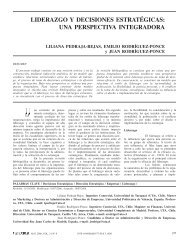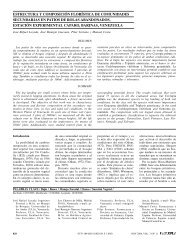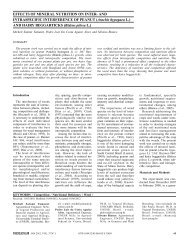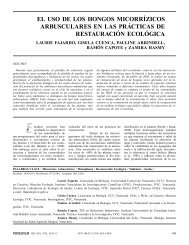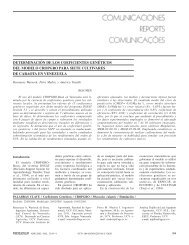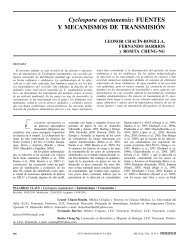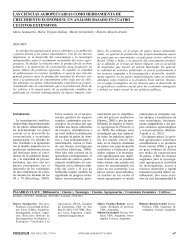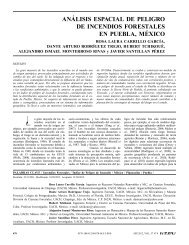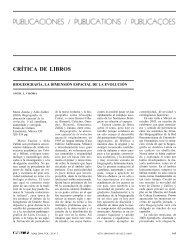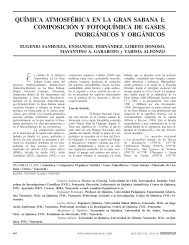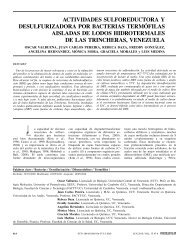effect of oxygen supply on water uptake in a melon ... - Interciencia
effect of oxygen supply on water uptake in a melon ... - Interciencia
effect of oxygen supply on water uptake in a melon ... - Interciencia
You also want an ePaper? Increase the reach of your titles
YUMPU automatically turns print PDFs into web optimized ePapers that Google loves.
EFEITO DA APLICAÇÃO DE UM OXIGENANTE SOBRE O CONSUMO HÍDRICO EM UM CULTIVO DE MELÃO<br />
SEM SOLO<br />
Pilar Mazuela<br />
RESUMO<br />
O sistema de cultivo sem solo permite um maior c<strong>on</strong>trole sobre<br />
os parâmetros de fertirrigação, especialmente em z<strong>on</strong>as áridas<br />
e semiáridas com má qualidade de água. O objetivo deste<br />
trabalho foi avaliar a aplicação de um oxigenante em um cultivo<br />
de melão (Cucumis melo L) e seu efeito sobre a produção<br />
e c<strong>on</strong>sumo hídrico em um sistema de cultivo sem solo. Para a<br />
oxigenação das raízes se utilizou peróxido de potássio. Fizeramse<br />
dois tratamentos. Utilizou-se solução nutritiva estándar (T0)<br />
e solução nutritiva com oxigenante (T1). Avaliaram-se os parâmetros<br />
de fertirrigação, produção e qualidade de frutos. Os<br />
resultados <strong>in</strong>dicam que a aplicação de peróxido de potássio utilizado<br />
como oxigenante estimula o c<strong>on</strong>sumo hídrico e melhora<br />
significativamente a eficiência hídrica de um cultivo de melão<br />
em sistema de cultivo sem solo.<br />
which means that it supports<br />
an electric c<strong>on</strong>ductivity <str<strong>on</strong>g>of</str<strong>on</strong>g> up<br />
to 2.5dS·m -1 , without affect<strong>in</strong>g<br />
producti<strong>on</strong>. In soilless culture<br />
systems, better management <str<strong>on</strong>g>of</str<strong>on</strong>g><br />
sal<strong>in</strong>e <strong>water</strong> is possible because<br />
<str<strong>on</strong>g>of</str<strong>on</strong>g> greater c<strong>on</strong>trol at fertigati<strong>on</strong>,<br />
which reduces the sal<strong>in</strong>e <str<strong>on</strong>g>effect</str<strong>on</strong>g><br />
<strong>on</strong> the plants. (Navarro et<br />
al., 1999; Shann<strong>on</strong> and Grieve,<br />
1999; Romero et al., 2001; Savvas<br />
et al., 2005; Carmassi et<br />
al., 2007).<br />
The objective <str<strong>on</strong>g>of</str<strong>on</strong>g> this work<br />
was to study the <str<strong>on</strong>g>effect</str<strong>on</strong>g> <str<strong>on</strong>g>of</str<strong>on</strong>g> potassium<br />
peroxide as an <str<strong>on</strong>g>oxygen</str<strong>on</strong>g><br />
generator and the <str<strong>on</strong>g>effect</str<strong>on</strong>g> <strong>on</strong><br />
<strong>water</strong> c<strong>on</strong>sumpti<strong>on</strong> <strong>in</strong> producti<strong>on</strong><br />
and fruit quality <strong>in</strong> mel<strong>on</strong><br />
(Cucumus melo L) crop <strong>in</strong> a<br />
soilless culture system.<br />
Material and Methods<br />
The work was carried out <strong>in</strong><br />
a polycarb<strong>on</strong>ate greenhouse <strong>in</strong><br />
the Azapa valley, extreme north<br />
<str<strong>on</strong>g>of</str<strong>on</strong>g> Chile, us<strong>in</strong>g the Galia type<br />
mel<strong>on</strong>. Plants were transplanted<br />
<strong>on</strong> 08/14/2006 <strong>in</strong>to bags 1m<br />
l<strong>on</strong>g c<strong>on</strong>ta<strong>in</strong><strong>in</strong>g as a substrate 25<br />
liters <str<strong>on</strong>g>of</str<strong>on</strong>g> diatomite (skelet<strong>on</strong> fossils<br />
with 95% silica), with three<br />
plants per bag. Harvest ended<br />
<strong>on</strong> 12/28/2006. The irrigati<strong>on</strong><br />
<strong>water</strong> c<strong>on</strong>ta<strong>in</strong>ed (mmol·l -1 )<br />
HCO 3<br />
-<br />
(2.9), Cl - (3.3), Na + (2.8),<br />
NO 3<br />
-<br />
(0.1), SO 4<br />
2-<br />
(2.3), Ca 2+<br />
(3.9), Mg 2+ (1.9) and K + (0.3).<br />
Two treatments were carried<br />
out. The c<strong>on</strong>trol treatment (T0)<br />
<strong>on</strong>ly the standard nutrient soluti<strong>on</strong>,<br />
similar to that reported by<br />
S<strong>on</strong>neveld and Straver (1994),<br />
was used. In the sec<strong>on</strong>d treatment<br />
(T1), Liberoxi® (1g·l -1 )<br />
was added <strong>on</strong>ce a week to the<br />
same nutrient soluti<strong>on</strong>. Liberoxy®<br />
c<strong>on</strong>ta<strong>in</strong>s ~7% potassium<br />
peroxide. A dose <str<strong>on</strong>g>of</str<strong>on</strong>g> 1g·l -1 was<br />
used accord<strong>in</strong>g to<br />
the recommendati<strong>on</strong>s<br />
<str<strong>on</strong>g>of</str<strong>on</strong>g> Urrestarazu<br />
and Mazuela<br />
(2005). Fertigati<strong>on</strong><br />
was supplied with a<br />
localised irrigati<strong>on</strong><br />
system. Every week,<br />
for each treatment,<br />
dra<strong>in</strong>ed <strong>water</strong> and<br />
dripp<strong>in</strong>gs were sampled<br />
and determ<strong>in</strong>ati<strong>on</strong>s<br />
were made <str<strong>on</strong>g>of</str<strong>on</strong>g><br />
the volume, <str<strong>on</strong>g>of</str<strong>on</strong>g> the<br />
pH with a mod. 2000 pH meter<br />
(Cris<strong>on</strong>, Barcel<strong>on</strong>a, Spa<strong>in</strong>),<br />
and <str<strong>on</strong>g>of</str<strong>on</strong>g> the electrical c<strong>on</strong>ductivity<br />
(EC) mod. 525 c<strong>on</strong>ductivity<br />
meter (Cris<strong>on</strong>, Barcel<strong>on</strong>a,<br />
Spa<strong>in</strong>). Chemical analyses <str<strong>on</strong>g>of</str<strong>on</strong>g><br />
drippers and dra<strong>in</strong>age were also<br />
performed weekly accord<strong>in</strong>g to<br />
Gil de Carrasco et al. (1994),<br />
us<strong>in</strong>g a model 2000i/SP liquid<br />
chromatograph (Di<strong>on</strong>ex, Sunnyvale,<br />
CA, USA) equipped with<br />
AS4A ani<strong>on</strong>ic and CS12 cati<strong>on</strong>ic<br />
columns (data not shown). Water<br />
c<strong>on</strong>sumpti<strong>on</strong> was calculated as<br />
the difference <strong>in</strong> the percentage<br />
<str<strong>on</strong>g>of</str<strong>on</strong>g> <strong>water</strong> dra<strong>in</strong>ed <strong>in</strong> the two<br />
treatments. The <strong>water</strong> efficiency<br />
was calculated as the volume <str<strong>on</strong>g>of</str<strong>on</strong>g><br />
<strong>water</strong> c<strong>on</strong>sumed per kg <str<strong>on</strong>g>of</str<strong>on</strong>g> fruit<br />
produced.<br />
Two different groups <str<strong>on</strong>g>of</str<strong>on</strong>g><br />
fruits, marketable and n<strong>on</strong>marketable,<br />
were established<br />
us<strong>in</strong>g EU regulati<strong>on</strong> L 100/11<br />
as standard (OJUE, 2001). For<br />
fruit quality, firmness (FF) was<br />
measured <strong>on</strong> three mel<strong>on</strong> fruits<br />
per replicati<strong>on</strong> and treatment<br />
us<strong>in</strong>g a pressuretester (7.9mm<br />
diameter pressure-tester needle)<br />
and expressed <strong>in</strong> terms <str<strong>on</strong>g>of</str<strong>on</strong>g> kg·m 2<br />
<str<strong>on</strong>g>of</str<strong>on</strong>g> crop surface. Total soluble<br />
solid (SS) c<strong>on</strong>tents were measured<br />
<strong>in</strong> the juice from three<br />
fruits per replicati<strong>on</strong>, us<strong>in</strong>g a<br />
Table I<br />
Fertigati<strong>on</strong> parameters, total <strong>water</strong> <strong>uptake</strong> and <strong>water</strong><br />
efficiency <strong>in</strong> mel<strong>on</strong> crop without (T0) and with (T1) <str<strong>on</strong>g>oxygen</str<strong>on</strong>g><br />
<str<strong>on</strong>g>supply</str<strong>on</strong>g><br />
Dra<strong>in</strong>age<br />
Treatment EC (dS m -1 ) pH % dra<strong>in</strong>age<br />
refractometer, and expressed <strong>in</strong><br />
ºBrix. Dry matter (DM) was<br />
also measured.<br />
Each experiment was c<strong>on</strong>ducted<br />
us<strong>in</strong>g a randomized complete<br />
block design us<strong>in</strong>g two<br />
treatments and three replicati<strong>on</strong>s.<br />
Each plot (experimental unit)<br />
had 12 mel<strong>on</strong> plants. S<strong>in</strong>gle t-<br />
Student probability was used<br />
to separate the means <str<strong>on</strong>g>of</str<strong>on</strong>g> treatments.<br />
The experimental designs<br />
and data analysis were based<br />
<strong>on</strong> the procedure described by<br />
Little and Hills (1987) and Petersen<br />
(1994). Calculati<strong>on</strong>s were<br />
made with a statistical package<br />
(Stagraphics, 1999).<br />
Results and Discussi<strong>on</strong><br />
Table I shows fertigati<strong>on</strong> parameters,<br />
<strong>water</strong> c<strong>on</strong>sumpti<strong>on</strong><br />
and efficiency. Water <strong>uptake</strong><br />
<str<strong>on</strong>g>of</str<strong>on</strong>g> T1 was significantly higher<br />
than that <str<strong>on</strong>g>of</str<strong>on</strong>g> the c<strong>on</strong>trol. This<br />
result agrees with that reported<br />
<strong>in</strong> tomato (Morard et al., 2000)<br />
and sweet pepper (Urrestarazu<br />
and Mazuela, 2005) when<br />
plants were grown <strong>in</strong> soilless<br />
culture with <str<strong>on</strong>g>oxygen</str<strong>on</strong>g> <str<strong>on</strong>g>supply</str<strong>on</strong>g>.<br />
The values <str<strong>on</strong>g>of</str<strong>on</strong>g> EC, pH and the<br />
percentage <str<strong>on</strong>g>of</str<strong>on</strong>g> dra<strong>in</strong>age are <str<strong>on</strong>g>of</str<strong>on</strong>g><br />
<strong>in</strong>terest, because <strong>in</strong> practice<br />
they are used by growers and<br />
Water <strong>uptake</strong><br />
(l·m -2 )<br />
Water efficiency<br />
(l· kg -1 )<br />
T0 2.64 7.82 18.20 170.39 63.57<br />
T1 3.07 7.79 14.97 176.80 53.25<br />
P ** ns * * **<br />
*, **, and ns: P≤0.05, P≤0.01, P≤0.001. and not significant, respectively.<br />
technicians to c<strong>on</strong>trol the horticultural<br />
crops <strong>in</strong> soilless culture<br />
(Urrestarazu, 2004), and thus,<br />
it is useful to know whether<br />
after treatment applicati<strong>on</strong>s the<br />
values <str<strong>on</strong>g>of</str<strong>on</strong>g> these parameters are<br />
different. There were significant<br />
differences between treatments<br />
<strong>in</strong> EC, percentage <str<strong>on</strong>g>of</str<strong>on</strong>g> dra<strong>in</strong>age<br />
and <strong>water</strong> efficiency, which was<br />
significantly different to the<br />
c<strong>on</strong>trol and l<strong>in</strong>ked to a higher<br />
<strong>water</strong> <strong>uptake</strong>. A decrease <strong>in</strong> the<br />
<str<strong>on</strong>g>oxygen</str<strong>on</strong>g> c<strong>on</strong>tent <str<strong>on</strong>g>of</str<strong>on</strong>g> the nutrient<br />
soluti<strong>on</strong>, together with a corresp<strong>on</strong>d<strong>in</strong>g<br />
<strong>in</strong>crease <strong>in</strong> the respirati<strong>on</strong><br />
rate at a certa<strong>in</strong> time <str<strong>on</strong>g>of</str<strong>on</strong>g><br />
the day (Hansen, 1977) could<br />
limit growth, at least for part<br />
<str<strong>on</strong>g>of</str<strong>on</strong>g> the day, unless the nutrient<br />
soluti<strong>on</strong> <str<strong>on</strong>g>oxygen</str<strong>on</strong>g> c<strong>on</strong>tent was<br />
<strong>in</strong>creased, suggest<strong>in</strong>g the need<br />
to <strong>in</strong>crease the <str<strong>on</strong>g>oxygen</str<strong>on</strong>g> c<strong>on</strong>tent<br />
around midday.<br />
This suggests that the <str<strong>on</strong>g>supply</str<strong>on</strong>g><br />
<str<strong>on</strong>g>of</str<strong>on</strong>g> <str<strong>on</strong>g>oxygen</str<strong>on</strong>g> as potassium peroxide<br />
<strong>in</strong> the nutrient soluti<strong>on</strong> stimulates<br />
<strong>water</strong> c<strong>on</strong>sumpti<strong>on</strong> under<br />
high sal<strong>in</strong>ity c<strong>on</strong>diti<strong>on</strong>s, as reported<br />
by Kaya et al. (2003,<br />
2007). More temporarily available<br />
<str<strong>on</strong>g>oxygen</str<strong>on</strong>g> could be the reas<strong>on</strong><br />
for a higher <strong>water</strong> absorpti<strong>on</strong>,<br />
and us<strong>in</strong>g the <str<strong>on</strong>g>oxygen</str<strong>on</strong>g> depleti<strong>on</strong><br />
c<strong>on</strong>cept <str<strong>on</strong>g>of</str<strong>on</strong>g> as def<strong>in</strong>ed by Gilderød<br />
and Adams (1983), a high-<br />
770 OCT 2010, VOL. 35 Nº 10



